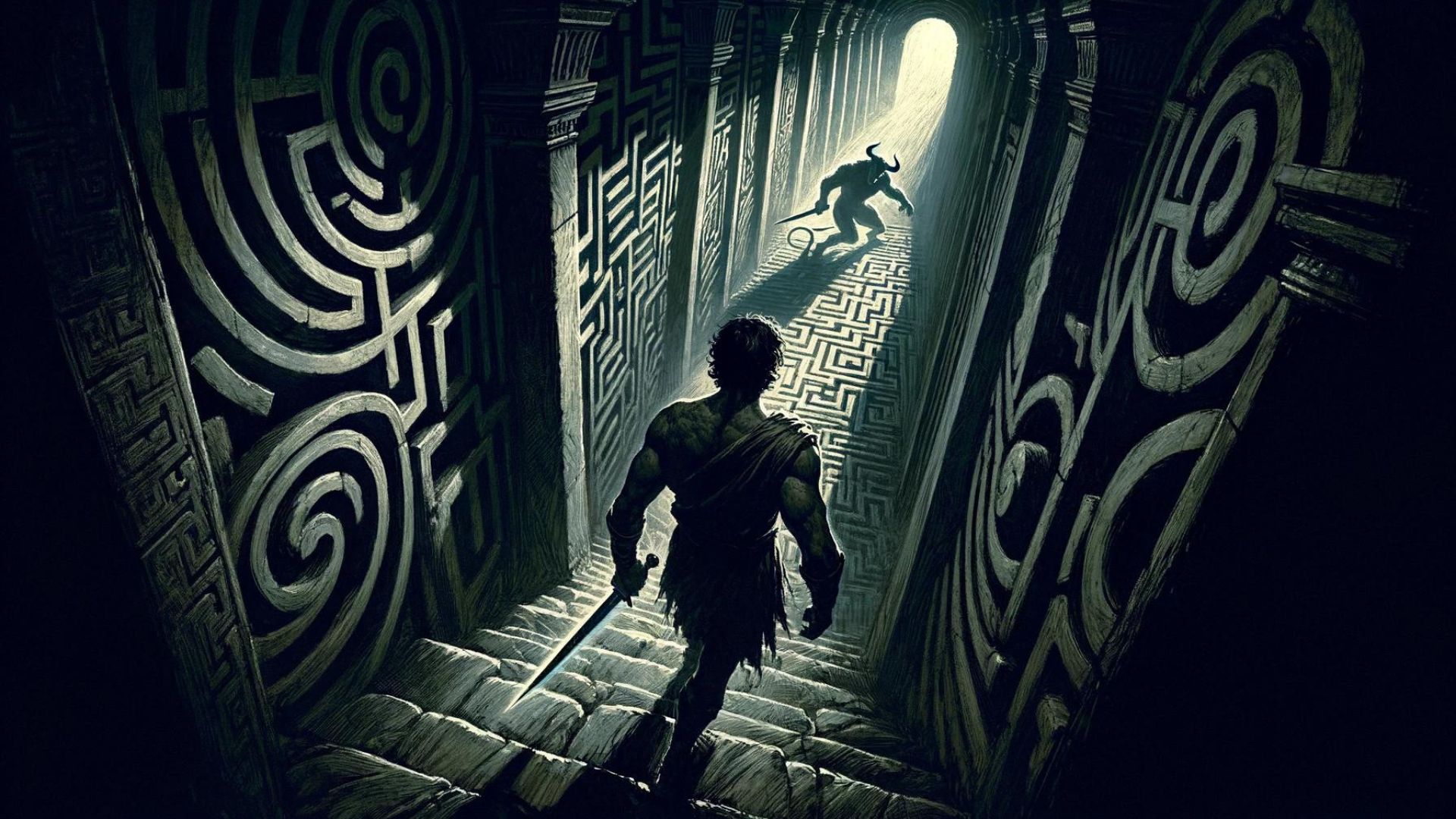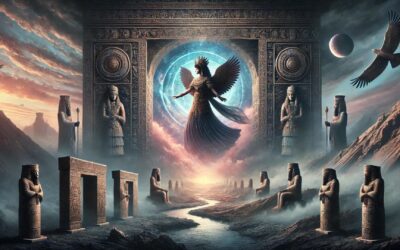Olympian Echoes: Theseus and the Minotaur
Long ago, in the sun-drenched land of Greece, there lived a hero named Theseus. Young, brave, and with the blood of kings running through his veins, his tale is woven tightly with one of the most fearsome creatures of myth – the Minotaur.
The story begins on the island of Crete, under the rule of the mighty King Minos. Minos, a son of the mighty Zeus himself, had incurred the wrath of the sea god Poseidon. As punishment, Minos’s wife birthed a terrifying creature: a monstrous being with the body of a man and the head of a bull – the Minotaur. In his rage and shame, King Minos commissioned Daedalus, a brilliant architect, and inventor, to create an inescapable prison for the beast. And so, the Labyrinth was born – a twisting, turning maze designed to trap anyone who dared to enter.
But this tale isn’t just about a monster. Years earlier, Athens had gravely offended King Minos, and a terrible price was exacted. Every nine years, seven young men and seven maidens were sent from Athens as a sacrifice, a tribute, into the Labyrinth. There, lost and afraid, they would meet their grisly end at the hands of the Minotaur.
Theseus, the prince of Athens, couldn’t stand for this cruelty. He vowed to sail with the next group of doomed tributes and slay the Minotaur, releasing Athens from its terrible burden. But his father, King Aegeus, was filled with despair. He made Theseus promise that if he succeeded, he would change the ship’s black sails to white, so his father would know he was alive before the ship even reached shore.
With a heavy heart, Theseus joined the tributes and journeyed to Crete. There, he caught the eye of Princess Ariadne, Minos’s daughter. Seeing in him not just a victim, but a courageous hero, Ariadne fell in love. However, she knew the fate that awaited Theseus inside the Labyrinth. Unwilling to watch him die, she sought out Daedalus for help.
The clever Daedalus gave Ariadne a simple yet brilliant tool – a ball of thread. She gave it to Theseus, instructing him to tie one end to the entrance of the Labyrinth and unwind it as he ventured deeper.
Armed with his sword and Ariadne’s guiding thread, Theseus entered the Labyrinth. The darkness closed in on him, the air heavy with the monstrous presence of the Minotaur. Deeper he ventured, the cries of the beast echoing through the winding passages. Finally, they stood face to face: hero against monster.
The battle was fierce. The Minotaur was huge and powerful, but Theseus was swift and driven by righteous purpose. In a desperate clash, Theseus finally struck the mighty beast down.
With the Minotaur slain, Theseus followed Ariadne’s thread out of the Labyrinth, leading the Athenian tributes to freedom. Ariadne joined Theseus and they sailed away from Crete.
Lessons from Legend
The story of Theseus and the Minotaur is more than just a thrilling adventure. It holds valuable lessons relevant even today:
- Facing our monsters: The Minotaur represents our deepest fears, those challenges that seem insurmountable. Theseus teaches us to face our monsters head-on, not to run from them.
- Clever over brute force: The Minotaur was immense, but Theseus outsmarted him, reminding us that even against overwhelming odds, strategy is key.
- The power of alliances: Without Ariadne’s guidance and the thread, Theseus may have wandered the Labyrinth forever. This highlights the importance of forging alliances and seeking help when needed.
Call to Action
Myths like that of Theseus and the Minotaur are embedded in our cultural DNA for a reason. They remind us of the timeless battles we all face. So, look around at your own life: What are your ‘monsters’? What labyrinths of challenge do you navigate? Remember the lessons of Theseus: face them with bravery, wit, and don’t be afraid to ask for guidance along the way!
Why Should You Care?
- Universal themes: Myths explore timeless human dilemmas: good vs. evil, courage, fear, love, and cleverness in the face of overwhelming odds. They are windows into our own challenges and potential.
- Cultural legacy: Greek mythology permeates art, literature, and even our language. Understanding these myths unlocks a richer understanding of the world around us.
- The Power of Story: Myths teach and inspire through powerful narratives. They are often more memorable and impactful than dry historical facts, offering lessons that linger long after you finish the tale.
Key Takeaways
- Confronting Challenges: Don’t be cowed by fears or monstrous obstacles, face them strategically and head-on.
- Overcoming Brutality with Strategy: Sometimes the biggest brute can be outsmarted through cleverness and planning.
- Accepting Guidance: Don’t be too proud to ask for help when facing the unknown. Alliances can be the difference between success and failure.
Keywords
- Theseus: Athenian prince, son of King Aegeus, hero who slayed the Minotaur.
- Minotaur: Creature with the head of a bull and body of a man, imprisoned in the Labyrinth.
- Crete: Island where King Minos ruled, location of the Labyrinth.
- King Minos: Powerful ruler of Crete, son of Zeus and father of Ariadne.
- Poseidon: God of the sea, angered by Minos, responsible for the Minotaur’s existence.
- Ariadne: Daughter of Minos, falls in love with Theseus and helps him defeat the Minotaur.
- Labyrinth: Complex maze built by Daedalus to house the Minotaur.
- Daedalus: Genius inventor and architect, designer of the Labyrinth.
- Tribute: The sacrifice of Athenian youths to appease Minos and feed the Minotaur.
- Thread: Ariadne’s tool for Theseus; represents guidance and a lifeline.
Frequently Asked Questions
- Did the Minotaur have a name? In some tellings, he’s called Asterion/Asterius (“starry one”).
- What happened to Ariadne after leaving Crete? Myths disagree. Some claim happy endings, others betrayals by Theseus and tragic fates.
- Is the Labyrinth real? No, but the Palace of Knossos on Crete, with its complex layout, may have inspired the myth.
- Why a bull? Bulls had cultural significance in Minoan civilization, perhaps explaining the Minotaur’s form.
Myth Buster
- Myth: Theseus was a flawless hero. Reality: He makes morally questionable choices, like abandoning Ariadne. This makes the story more human and relatable.
Let’s Talk
- Do you think Theseus was justified in using Ariadne? Why or why not?
- What modern-day situations feel like facing your own “Minotaur”?
- If you could give Theseus one piece of advice before entering the Labyrinth, what would it be?
Get involved! Share your own thoughts and questions in the comments below!











0 Comments